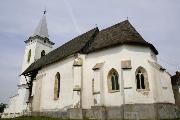Hodod - The Calvinist Church
Document tools
 Formerly situated in the county of Sălaj, Hodod was an important centre of the region until the beginning of the 20th century. The estate was part of the king’s domain until 1383, when it was donated to Jakcs of Coşeiu family, together with the neighboring villages: Nadişu Hododului, Bogdand and Corund. The owners built a castle in the centre of the domain, mentioned first in 1399. Following the extinction of the Jakcs family, the domain was achieved by the Wesselényi family, the patrons of the church untill the 20th century. Hodod was mentioned as market town in 1482. The churches of the nearby villages were all affiliated to the church of Hodod, dedicated to St.
Formerly situated in the county of Sălaj, Hodod was an important centre of the region until the beginning of the 20th century. The estate was part of the king’s domain until 1383, when it was donated to Jakcs of Coşeiu family, together with the neighboring villages: Nadişu Hododului, Bogdand and Corund. The owners built a castle in the centre of the domain, mentioned first in 1399. Following the extinction of the Jakcs family, the domain was achieved by the Wesselényi family, the patrons of the church untill the 20th century. Hodod was mentioned as market town in 1482. The churches of the nearby villages were all affiliated to the church of Hodod, dedicated to St. Ladislaus during the Middle Ages. The Reformation was accepted rather early by the inhabitants of Hodod: the first Calvinist priest of the village, Mihály Horváth, a former student in Wittenberg, was mentioned in 1557. The present church was built in Gothic style in the 15th century. The edifice has a single nave and a tower joined to the western façade. The sanctuary is closed with three sides of an octagon. The narrow windows and the irregularities of the plan suggest that a part of the previous church was reused during the construction. The gothic vault of the sanctuary has two segments and it is sustained by buttresses on the exterior. On the eastern and southern side of the sanctuary, the double windows still keep the Gothic mullions. The sanctuary is separated from the nave by triumphal arch in
Ladislaus during the Middle Ages. The Reformation was accepted rather early by the inhabitants of Hodod: the first Calvinist priest of the village, Mihály Horváth, a former student in Wittenberg, was mentioned in 1557. The present church was built in Gothic style in the 15th century. The edifice has a single nave and a tower joined to the western façade. The sanctuary is closed with three sides of an octagon. The narrow windows and the irregularities of the plan suggest that a part of the previous church was reused during the construction. The gothic vault of the sanctuary has two segments and it is sustained by buttresses on the exterior. On the eastern and southern side of the sanctuary, the double windows still keep the Gothic mullions. The sanctuary is separated from the nave by triumphal arch in form of a pointed arch. The buttresses and the marks on the walls of the nave suggest a previous vaulting, similar to the one in the sanctuary. The present ceiling is flat, painted with vegetal motifs. On the southern side, the two large windows kept partially the gothic mullions. The western semicircular door, now situated between the tower and the nave is simple. The northern door has a simple stone frame in pointed arch, with a semicircular profile. The present tower was built at the beginning of the 20th century. The most significant element of the furniture is the pulpit, built by Dávid Sipos in 1754. The façade of the pulpit is decorated with vegetal motifs, and contains an inscription with the donators name (Ferenc Wesselényi and his wife, Zsuzsanna Rhédei) and with the year of production. The church has three bells dating from the 17th century: the oldest one was made in 1603, in Kosice (Kassa), the biggest belonged to the castle, and it was made in 1619, while the smallest in 1591. In the last few decades, the earth flows affected seriously the church, so that the reconstruction of the nave is necessary. (SzP).
form of a pointed arch. The buttresses and the marks on the walls of the nave suggest a previous vaulting, similar to the one in the sanctuary. The present ceiling is flat, painted with vegetal motifs. On the southern side, the two large windows kept partially the gothic mullions. The western semicircular door, now situated between the tower and the nave is simple. The northern door has a simple stone frame in pointed arch, with a semicircular profile. The present tower was built at the beginning of the 20th century. The most significant element of the furniture is the pulpit, built by Dávid Sipos in 1754. The façade of the pulpit is decorated with vegetal motifs, and contains an inscription with the donators name (Ferenc Wesselényi and his wife, Zsuzsanna Rhédei) and with the year of production. The church has three bells dating from the 17th century: the oldest one was made in 1603, in Kosice (Kassa), the biggest belonged to the castle, and it was made in 1619, while the smallest in 1591. In the last few decades, the earth flows affected seriously the church, so that the reconstruction of the nave is necessary. (SzP).References:
Emődi Tamás, A hadadi református templom, Kolozsvár, 1996. Erdélyi műemlékek 19.
Daniela Marcu-Istrate – Péter Levente Szőcs: „Sondaje arheologice la biserica reformată din Hodod (jud. Satu Mare)”. Studii şi Comunicări Satu Mare, seria Arheologie. XVII–XXI/1 (2000–2004). 113–120.
 Printable version
Printable version
 Send as email
Send as email
